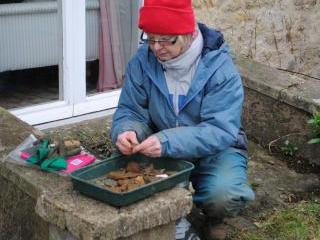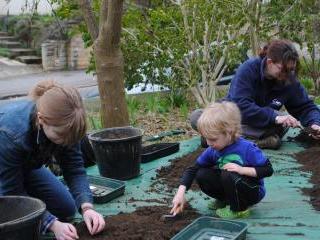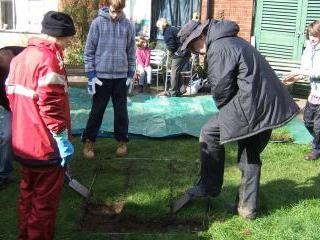April 2011
East Oxford Archaeology Project: Newsletter April 2011
Despite holiday periods and time away for some of the team, a great deal has happened in the last two months, with some exciting field work and enjoyable and interesting visits to the National Monument Records in Swindon and Christchurch’s archives. Investigations are beginning to concentrate on certain areas including Church Cowley, Littlemore, Temple Cowley and Iffley; other ‘hot-spots’ will no doubt follow.
Both the twelfth century AD and the Second World War history and archaeology of our area are already proving fascinating themes of investigation; while excellent new research has been launched by volunteers into place names and the Knights Templar, amongst other things.
Here’s a roundup of what has happened in the last few weeks:
Talks: the Project Tour of East Oxford venues continues (with some excellent speakers)
The talks giving the background to East Oxford and Oxfordshire’s archaeology have continued to be very popular. We haven’t tried to achieve a chronological order but that is because we have waited to secure the best possible speakers – again also people who have worked and mostly live locally.
Gary Lock talked about on the Iron Age in Oxfordshire: there is clearly huge potential for filling the gaps in knowledge about a fascinating period in this classic Upper Thames Valley location. Trevor Rowley’s evening on1066and the Normans was extremely popular with Trevor delivering a rousing talk underlining how important the period was in the area – in particular the twelfth century – despite the lack of research.
Coming soon:
Anne Dodd: on the Anglo-Saxons 400 – 1000 AD, 3 May 2011 at 7pm, at the St James Church Centre, Beauchamp Lane.
Ann Cole: on Placenames in Oxford and Oxfordshire, 10 May 2011 at 7pm, at the Cheney Community Hall, Cheney School.
Liz Woolley: on Victorian Oxfordshire, 7 June 2011 at 7pm, venue to be confirmed.
David Beard: on the Knights Templar and their Preceptories
Graham Keevill: on building survey, date and venue to be confirmed.
Training sessions and Trips
Christchurch Archive: Judith Curthoys the Christchurch archivist has been extremely helpful. A group of us went to look at the maps and plans held in the Archive (housed in the old College brew-house). Some of the most relevant maps are now available to us to scan and work on further. The maps, for example, give more detail about older buildings in the village of Church Cowley and the layout of fields in the area.
National Monuments Record, Swindon: After a fascinating talk and then tour of the Records Office a group spent the afternoon looking at old aerial photographs for the East Oxford area. Some of the most interesting were United States Air Force photos from the Second World War snapped over the Cowley airfield. Friendly planes could fly low and the photos picked up the creative methods used by ground crew to disguise the grass runways of the airfield. Hedge lines had been painted across the turf to break up the open expanse and the perimeter roadway turned into a painted brook! We will do a further trip for those who were unable to make it this time round. Contact: paula@archeox.net to be put on the list.
Ashmolean Museum: We have had a very exciting glimpse at some of the collections and individual objects from east Oxford stored in the Ashmolean Museum. We looked at Stone Age tools, Bronze Age palstave axes, Roman pottery, and a range of Saxon and medieval objects, but much more remains in storage. The majority were found in the early 20th century and have never been properly investigated. Staff from the Museum are very keen for east Oxford volunteers to help discover more about the objects and the sites where they were found. We will be putting together some ideas for small research projects - if you are interested in investigating any of these objects contact jane@archeox.net or paula@archeox.net
The website: Our new improved website is almost ready. We have test pit and site reports, past and present newsletters, articles and upcoming events, and have prepared factsheets with information covering the main themes in archaeology. Already we have a number of very interesting reports written by volunteers, and some of your photographs on the website, and we hope you will contribute many more in the coming months. Once it goes ‘live’ please help us to test it and let us know how you would like it to develop.
Out and about
Work on the ground gathered pace in March and April, with exciting results.
Please let us know jane@archeox.net if you would like to dig a little trench in your own garden. We will come round with equipment to train and help you to excavate and record your mini-dig as it should be done. And everything is returned to the way it was before! Each mini-dig adds greatly to the big picture.
 Bartlemas mini-excavation, 28 February – 1 March:
Bartlemas mini-excavation, 28 February – 1 March: the first test-pit in the Bartlemas landscape went ahead in chilly and damp weather but with warm hospitality from Sarah and Christopher Franks. We were uncertain what to expect as we opened the pit: elsewhere on the site there had been a deep, deliberate build-up of soil – perhaps related to drainage. But we were in luck as less than half a metre down the team discovered a gravel garden surface and a plant bed, probably part of the garden arrangement reflected in the early 19th century plan. It was exciting to learn that archaeological deposits were surviving and well-presrved. Then below the spread of gravel (so perhaps 18th century) we found the foundations of a carefully dismantled stone wall. This wall had been substantial – 0.5m wide with solidly constructed foundations – and on an alignment different to any walls/fences on known plans. We then noticed that the lawn grew distinctly differently to the east of this hidden wall-line with woodland species of flowers persistently emerging each year. And the line of the wall also joined the end of the old barn to the original course of the Bartlemas track.
Ark-T Centre excavations, 19-20 March: 

The excavations in the two gardens at Ark-T Centre/John Bunyan Baptist Church produced really interesting results. A considerable number of you, including people linked to the Centre and Church, were involved in excavating, retrieving finds from soil, recording the results and using the new GPS. We were made very welcome and visitors and passers-by asked questions and told us their memories of the area. One very young enthusiast joined us for some of a morning!
In the side garden we were excited to discover a medieval ground surface with pottery and bone over half a metre down; below that we found a narrow ditch which held much ceramic building material, a sherd of the white locally made Roman mortaria (large open bowl for grinding food e.g. herbs) and other possibly Romano-British pottery. So the excavation confirmed that Crowell Road was an old hollow lane dug down into the landscape, that medieval archaeology from the early days of Church Cowley survives and gave another indication of the extent of the Roman archaeology in the area. Meanwhile the steady drip of water along the roots in the test-pit demonstrated why both a pump and a well were recorded in the area of the gardens.

The inner garden had been stripped of much of the humanly influenced layers but allowed us to investigate the natural geology; again finds suggested there was Romano-British activity in the area.
‘Hot-spot’ weekends – Iffley/Rose Hill: the next hot-spot weekend will be in Iffley and Rose Hill on 11-12 June. As at the Ark-T we will combine studying the old maps and existing information with some survey, and this time, allotment work and test-pit digging. If you live in this area and would like to dig a test-pit in your garden then please let us know. The impact on the garden is minimal – you really can hardly tell where any of our completed pits were after a couple of weeks.
Contact: jane@archeox.net
Geophysics: The initial teething problems with the geophysics kit has been resolved and we will begin surveying again very soon. We have access to a number of areas where the potential to discover Iron Age settlement, evidence for the Roman pottery industry, activities along the Roman road, and possible Civil War sites, is very good.
Contact: paula@archeox.net
Other Project work: we have also been continuing our work with groups connected to the Museum of Oxford, with schools and local community groups, including at day care centres. At one such visit we spoke to local people who had worked at the Cowley factory in the Second World War when it was the hub for repairing and recycling airplanes for the whole country.
Coming soon
We will be:
· Focusing on excavating of test-pits in gardens around the area, concentrating on our hot-spots and training more of you to complete both the excavation and recording process.
· Going on a first visit to the East Oxford collections of objects stored in the Ashmolean museum.
· Continuing the geophysics and surveys.
· Digging another test-pit in Bartlemas.
See you all soon
The Project Team
Any questions or to register for the geophysics, maps or excavation teams? Contact:









